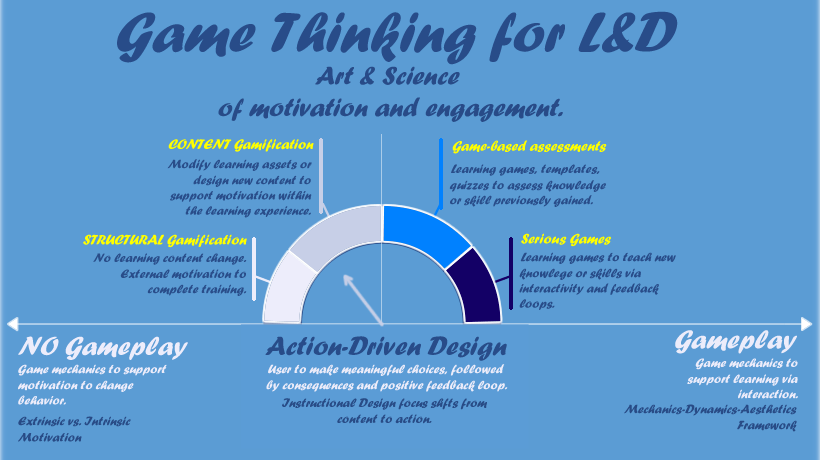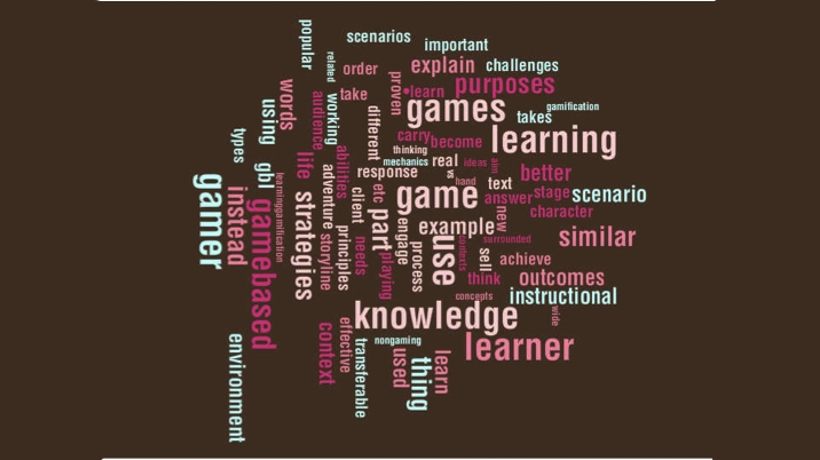Game Thinking In Action
"A Subject Matter Expert hands over the content deck, supporting documents, notes, and a tight timeline. You're expected to play the role of the learning blender: you put all this info in, press an ID button, and provide the magic juice of knowledge and skills.
When you raise concern about the large volume of fluff, the SME tells you these are all important things to know, so if they don't fit on the screen, let's use a smaller font! Being a responsible ID, you add some actual interactions where the learners practice these important skills. At the first round of review, it is clear that the course is too long. We need to cut.
What's the first to go? The "extra activities" you made up. After the "gold" version of the course, one of the business stakeholder's response is that the content is dry. Boring. We need to gamify it. And you add points, badges, even whip up a leaderboard.
And here's the punch line: after 90 days of the launch, there's no uptake in performance at all. Except for one team. Investigation reveals that a supervisor took the 45 minute training, and created a one-pager checklist for his team. Shared it in a huddle, and followed up on the items afterwards."
Does The Above Scenario Sound Familiar To You?
Of course, this is a made-up story, but I'm sure you've experienced some of these frustrating elements in your L&D career. So, what can we do about them? How could we convince subject matter experts and stakeholders that they're wasting their resources when addressing a non-training issue with training? Is it our problem at all? As a learning consultant at Kineo, I believe my obligation is to provide our business stakeholders with the best problem-solving options, so they can make an informed decision.
When a stakeholder comes to you with "we need training yesterday", it is often too late. You are considered an order taker, a learning blender. Using game thinking might be worth a try to move from "order taking" to problem-solving. Game thinking does not start with building a game or gamifying anything. It starts with asking the right questions.
Am I Asking The Right Questions?
I had the chance to speak at the ATD International Conference and Exposition 2018 in San Diego, CA. If you missed the conference, there are great curated resources by David Kelly and JD Dillon [1]. My session posed a question about one of the most misunderstood trends in L&D: "Isn't gamification just sugarcoating boring eLearning content?"
The answer to the question is simple: "Yes, it can be. But why would you do that?".
I asked participants in the interactive session to pose their own questions to me. If you are interested in what your fellow "gamifiers" were asking, you'll find the questions and answers on my blog [2]. Many of the questions revealed the confusion about gamification vs. games vs. game-based learning vs. game-based assessments. Often, these terms get mixed under the same label: "gamifying content".
Do Not Gamify Your Content!
The scope of the article is not to explain the differences between the terms above, rather focus on where to start with gamification. Nowhere near the content! Gamifying content is not the best place to start.
"…The authors conclude that the starting point in gamifying online education should be learners’ needs, motivations and goals, rather than a platform-centric approach that strives to use technical features to hit some pre-defined performance metrics." [3]
Gamification is not about playing games or making boring content "fun." Gamification is about motivating people to do things. The mistake L&D practitioners often make is that they try to use gamification to motivate people to take courses or read stuff. That is to take the same irrelevant, boring courses. Adding points, badges and leaderboards to boring eLearning courses is sugarcoating. A better question to ask: "Why is my course boring?".
Gamification, as in applying game elements in a non-game context to motivate people to do meaningful actions, can be effective. However, the target for L&D should not motivate people to take courses. It should be about motivating people to do activities that directly contribute to their desired knowledge or skills.
Actions are what we should be gamifying, not content. I strongly suggest starting out with game thinking in mind, a gameful approach to problem-solving without focusing on the delivery method. You may end up with a game, gamification, game templates, gameful design, or nothing remotely gamelike at the end. Game thinking starts with knowing what actions people should be doing to achieve the performance goals, and ultimately, their business goals. If you're interested in game thinking applied to designing an effective customer journey, check out Amy Jo Kim's explanation [4]. Challenge yourself to think about people as customers, rather than learners, whose desire at the end of the road is mastery. Our job is not to take them on detours but providing motivation through knowledge, skills and just in time performance support, so they can continue on their journey. In the hearing of this challenge is not content we create but actions people do and decisions people make.
How To Get To Actions?
Enough of theory. The rest of this article is about one, single slide in my presentation that triggered the most interest: Mighty Cards.

Mighty Cards is an example of using game thinking to problem-solving. Again, game thinking for L&D encourages us to think about problems through gameful approaches via actions and not content. Actions drive behaviors, which in return, drive performance. Analyzing a problem through the lens of the game thinking, we're focusing on what people need to do, rather than they need "to know".
At the end of the process, we may end up with actual gameplay, not gameplay at all, gameful design, or a simple checklist. Mighty Cards is an example of a tool that could be a lot more sophisticated, a lot more interactive, and a lot more gamified. Sometimes, all you need is to frame an activity like a game.
"… merely making an activity seem like a game impacts learners’ engagements." [5]
Keep it simple! Might Cards is nothing fancy. You can create your version or just order these that I'm using. Either way, they help us focus on actions need to take place and the barriers that might hold people back.
What's Action Mapping?
Cathy Moore's action mapping process is one of the most useful things in Learning and Development I've tried in the last 20 years [6]. In short, you start with a business goal, performance goal, and behaviors. Then continue with actions. What do people need to do to achieve those goals? In what context? What practice, if any they need? What is the minimum information they need to accomplish that?
The Barriers/Obstacalities
Where Mighty Cards help is the facilitation of the conversation around whys! Why are people not doing what they're doing? Why are they doing what they're not supposed to be doing? Without knowing why the actions are not taking place, we just throw shots in the dark, hoping that it hits the target. (For example, telling people to complete a form properly a hundred times may not be the best approach to train when the real problem is that they have limited time, so they just pick the first item in the drop-down.)
The cards can facilitate the conversation by guiding participants' thoughts how to think about issues differently:
- Is it knowledge they need to be able to recall from memory?
- Is it knowledge they need to be to able to use with the help of an external tool? (So there's no point in memorizing it!)
- Is it a skill they need to practice?
- Is it motivation? They know what to do, they know how to do it. Why?
- Is it environment? Something we can't control?
From Theory To Practice
Using Might Cards (and various other iterations of this approach before) helped me work with clients to move from "thinking training content" to "thinking problem-solving". I often start the meeting with this: forget training. Let's talk about why you are here, and what would make your time worth staying. Let's bring out all the issues around the business problem, whether they "training-related" or not. When I bring out the cards in a meeting, these tangible, touchable game elements help me change the "just another meeting" attitude. I usually follow up with the permission that anyone can leave and multitask if they don't find the session useful.
The goal of the stakeholder session with Might Cards is not to find training solutions. It is to map out systematically all the issues that relate to the problem situation. Anything that stands in between their business goal and reality today. And why? Some of the issues we uncover will be addressed by training. Some will require simple performance support. While others would need organization change or other mighty things we don't have control over. But maybe someone else has. Who should we also connect with?
At the of the day, we'll walk away with what we believe we can address by learning. And guess what, focusing on actions, people, their motivations and barriers, gamification might have a much better chance to make an impact on the job, and not just on a virtual leaderboard.
References:
[1] ATD2018 Curated Resources:
JD Dillon: https://flipboard.com/@jddillon/atd-2018-s9bi2e5ly
David Kelly: http://davidkelly.me/2018/05/the-2018-atd-international-conference-and-expo-backchannel-curated-resources-atd2018/
[2] Gamification FAQs from ATD 2018 session: https://www.rabbitoreg.com/
[3] Hansch, A., Newman, C., & Schildhauer, T. (2015). Fostering Engagement with Gamification: Review of Current Practices on Online Learning Platforms. (November 23, 2015). HIIG Discussion Paper Series No. 2015–04. Retrieved from http://dx.doi.org/10.2139/ssrn.2694736
[4] Amy Jo Kim about game thinking: https://medium.com/@amyjokim/game-thinking-explained-fa6da3e8debb
[5] Lieberoth, A. (2015). Shallow gamification – psychological effects of framing an activity as a game. Games and Culture, 10(3), 249–268.
[6] Cathy Moore's action mapping: http://blog.cathy-moore.com/action-mapping/








